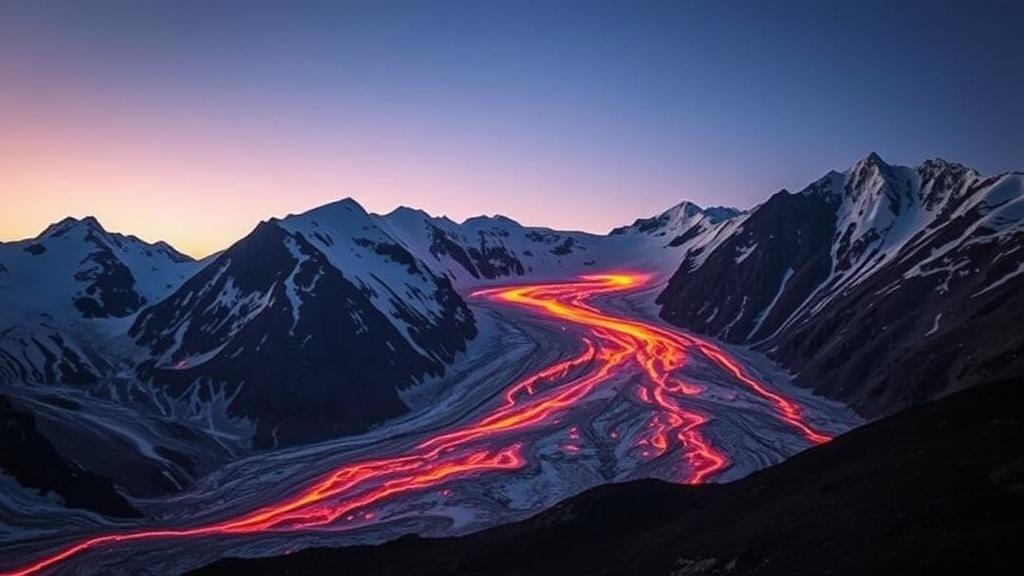Searching for the “Frozen Flame,” a glacier in the Himalayas with a fiery hue that defies explanation.
Searching for the Frozen Flame: A Unique Glacier in the Himalayas
The Himalayas are home to some of the most breathtaking natural wonders on Earth, ranging from soaring peaks to pristine lakes. Among these marvels lies an enigmatic glacier known as the Frozen Flame. Located in the northern region of India, specifically within the state of Uttarakhand, this glacier is renowned for its inexplicable fiery hue that contrasts starkly with the surrounding icy landscape, captivating researchers and adventurers alike.
The Phenomenon of the Frozen Flame
The Frozen Flame is not just a name–its a phenomenon that challenges scientific understanding. The fiery hue that characterizes this glacier is thought to be the result of unique mineral deposits within the ice, particularly iron oxide. As sunlight refracts through the ice, it creates a mesmerizing orange-red glow. This radiant effect draws parallels to the way light scatters in a campfire, illuminating the surrounding darkness.
Location and Accessibility
This glacier is situated near the sacred lake of Roopkund in the Chamoli district of Uttarakhand. Accessible primarily through trekking, adventure enthusiasts typically embark on a multi-day journey to witness this spectacle. most common route begins from Loharjung, covering approximately 50 kilometers and taking around six days to complete, depending on trekking speed and weather conditions.
Historical Context of the Region
The region surrounding the Frozen Flame is steeped in history and folklore. Local legends recount tales of an ancient king who, during a hunting expedition, stumbled upon the lake of Roopkund, which is nearby. In 1942, the lake drew attention when human skeletons were discovered, believed to be the remnants of people who perished in a tragic event. This historical context enriches the allure of the glacier, making it a must-visit site for both nature lovers and history buffs.
The Importance of Glacial Research
The study of glaciers is critical for understanding climate change and its impacts on global ecosystems. Glaciers act as indicators of climatic shifts, providing scientists with valuable data on temperature changes and precipitation patterns. The Frozen Flame, with its unique characteristics, offers researchers an opportunity to explore sedimentation processes and the sources of the extraordinary mineral deposits that contribute to its fiery appearance.
- The average temperature of the region can drop to as low as -10°C during the winter months.
- The glacier is one of many in the Himalayas that have been rapidly retreating due to climate change, with some studies indicating a loss of 50% of ice mass in recent decades.
Real-World Applications
Beyond its aesthetic appeal, the exploration of the Frozen Flame and similar glaciers has practical applications. As the ice melts, it reveals insights into ancient climatological conditions, aiding predictions for future trends. This information is crucial for farmers, urban planners, and policymakers who rely on accurate climate data to make informed decisions regarding resource management.
Conclusion: The Adventure Awaits
The quest for the Frozen Flame presents not just a physical adventure but also an opportunity to engage with the profound complexities of our natural world. Adventurers planning to embark on this journey should prepare adequately, considering the challenging weather conditions and the physical demands of trekking at high altitudes. experience of witnessing the fiery hues of this remarkable glacier will leave lasting impressions that resonate well beyond the journey itself.
For those eager to explore the Frozen Flame, consider joining guided trekking expeditions that provide not only safety but a deeper understanding of the ecological and cultural significance of the area. As the world grapples with climate change, places like the Frozen Flame remind us of the beauty and fragility of our planet.



